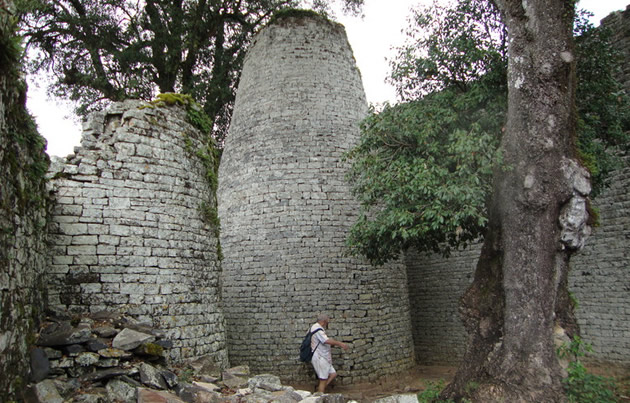History of Great Zimbabwe

 By Sam Mujakwi and Tinashe Chikoko
By Sam Mujakwi and Tinashe Chikoko
The name Zimbabwe is derived from the Shona “dzimba dzemabwe”, meaning houses of stone or stone buildings, today symbolised by the Great Zimbabwe Ruins near the present day town of Masvingo.
Zimbabwe has a rich history, not only of achievement, innovation, co-operation and economic prosperity, but also of conflict, trials and tribulations that reflects the dynamism of its peoples.
Many scholars, past and present, have enhanced our knowledge of the Zimbabwean past through their works. Particularly important in our understanding of the pre-colonial past have been the works of archaeologists, linguists, historians, oral traditions and records of 16th century Portuguese traders that interacted with central and southern Africa during that time.
Pre-colonial era
Pre-colonial Zimbabwe was a multi-ethnic society inhabited by the Shangani/Tsonga in the south-eastern parts of the Zimbabwe plateau, the Venda in the south, the Tonga in the north, the Kalanga and Ndebele in the south-west, the Karanga in the southern parts of the plateau, the Zezuru and Korekore in the northern and central parts, and finally, the Manyika and Ndau in the east.
Scholars have tended to lump these various groups into two huge ethnic blocs, namely ‘‘Ndebele’’ and ‘‘Shona’’ largely because of their broadly similar languages, beliefs and institutions. (The term Shona itself is however, an anachronism, it did not exist until the 19th century when it was coined by enemies as an insult; it conflates linguistic, cultural and political attributes of ethnically related people).
The political, social, and economic, relations of these groups were complex, dynamic, fluid and always changing. They were characterised by both conflict and co-operation.
Kingdoms at Great Zimbabwe
Huge empires emerged in pre-colonial Zimbabwe, namely the Great Zimbabwe State, the Mutapa State, the Rozvi State, the Torwa State, and the Ndebele State. Great Zimbabwe was a majestic ancient stone city that flourished near the modern town of Masvingo from about 1290 to 1450 on the strength of a powerful and organised society.
It thrived on the foundation of favourable agricultural conditions, cattle-keeping, great mineral wealth and most significantly, both regional and long distance trade.
Trade was conducted with such far away areas as China, India, the Middle East and the Near East, East and West Africa, among other regional and inter-regional areas. Persian bowls, Chinese dishes, Near Eastern glass and other such items have been excavated at Great Zimbabwe, signifying the trade contacts with these far away places.
Other trade goods identified with Great Zimbabwe included a variety of glass beads, brass wire, seashells iron wire, axe heads and chisels.
Local goods included ivory, iron gongs, gold wire and beads, soapstone dishes and other items. The art of weaving was practised and some locals wore locally woven cloth. Some of the finest and most enduring finds at Great Zimbabwe were the seven or so soapstone bird carvings sitting on decorated monoliths. It is speculated that these were religious symbols signifying the point that Great Zimbabwe may have been a political, economic and cultural centre of great religious importance.
Exodus of kingdoms and people from Great Zimbabwe
The period of prosperity at Great Zimbabwe was, however, followed by decline and abandonment due to shortages of food, pastures and natural resources in general, not only at Great Zimbabwe, but in the city’s most immediate neighbourhood.
Shona traditions identify Mutota, a Mbire ruler, as the leader who led his people to found a new kingdom, the Mutapa, in the Dande area in the Zambezi Valley where smaller and less spectacular madzimbahwe were built. By the late 15th century, Great Zimbabwe had completely lost its wealth, trade, political and cultural importance.
Today, Great Zimbabwe is preserved as a valuable cultural centre and tourist attraction. It epitomises what has certainly been the finest and highest achievement of Shona civilisation.
By about the 14th century, the process of political centralisation had begun among the Shona-speaking people. This has largely been attributed to good economic conditions that ensured successful harvests and the accumulation of surplus grain, animals and other forms of wealth, which in turn stimulated population growth, allowing some individuals to assume positions of leadership. The decline of Great Zimbabwe thus allowed Mutota to conquer the Korekore and Tavara of the Dande and Chidema areas.
Oral traditions have it Mutota’s victims were so impressed that they nicknamed him Mwene Mutapa, “owner of conquered lands” or ‘master pillager’, hence the birth of the Mutapa dynasty. He then embarked on an expansionist policy that resulted in the creation of a vast empire the Mwene Mutapa or simply, Mutapa State, which stretched from the Zambezi Valley into the Mozambique lowlands and towards the fringes of the Kalahari Desert. The Mutapa’s control in these far away lands may, however, have been peripheral and not regular. (In fact, the vastness of the empire partly explains the breakup of the Mutapa state.)
Coming of missionaries
An important feature of the Mutapa State way of life was the close link between politics and religion. So, when the Portuguese reached Mutapa, they sought to penetrate it through religion. When Father Gonzalo da Silveira arrived in December 1560, he worked on converting the royal family to Christianity. He was largely successful in this because the vast empire had become heavily riddled with conspiracies, coup plots, succession disputes and civil wars to the extent that the reigning Mutapa probably wanted Portuguese help to hold on to power.
The King, however, soon turned around and renounced Christianity, leading to the murder of da Silveira, henceforth marking a turn in Portuguese–Mutapa relations. Punitive expeditions were sent to assist the Mutapa’s enemies, particularly Mavhura, a rival claimant to the Mutapa kingship.
For their help, the Portuguese demanded that Mavhura sign treaties of vassalage to Portugal, thus tying the Mutapa State to the Portuguese crown.
The Portuguese took this opportunity to advance their imperial interests by using slave labour to work on the land they acquired under these treaties. This resulted in many armed conflicts in the area, causing many Shona to flee to the south where Changamire’s rule was being established.
This era of puppet Mutapas, however, came to an end due to the rise of reformists within the Mutapa royal family, led by Mutapa Mukombwe in 1663, eventuality giving rise to a class of rulers known as the VaRozvi.
Between 1663 and 1704, Mukombwe and his successors successfully drove the Portuguese off their prazos with the support of the Tonga in the Zambezi Valley and the Chikanga of Manyika. Mukombwe achieved the important feat of resettling Mutapa families in the lands he had freed.
However, Mutapa Mukombwe faced rebellion, a development that gave rise to the Rozvi State. Changamire Dombo defeated a punitive Mutapa army after rebelling in 1684. He established and consolidated his control in the western Butwa/Butua area once dominated by the Kalanga as well as in the lands of the Manyika and in the trading centres of mainland Mutapa. Dombo and his successors established the Changamire dynasty and ruled over the territory that includes most parts of what is now Zimbabwe.
Possible Exam questions about Great Zimbabwe.
1. List and describe the Great Zimbabwe kingdoms?
– How to answer:- you give a list of these ancient kingdoms at Great Zimbabwe, you give a brief summary of their leadership, hierarchy, their religious, political and socio-economic activities.
2. Explain the rise and fall of the Great Zimbabwe kingdoms?
– How to answer:- You describe how States like Rozvi, Mutapa were founded at Great Zimbabwe and how the Ndebele State got involved at Great Zimbabwe. You then list and explain factors that led to the rise and fall of the Great Zimbabwe ie shortages might have contributed to the fall and abandonment of Great Zimbabwe.
3. Discuss how the use of slavery and forced labour contributed in the building of Great Zimbabwe?
– How to answer:- You need to explain methods used by powerful leaders like Chirisamhuru of the Rozvi state in forcing captives and subjects in building the House of Stone.







Comments